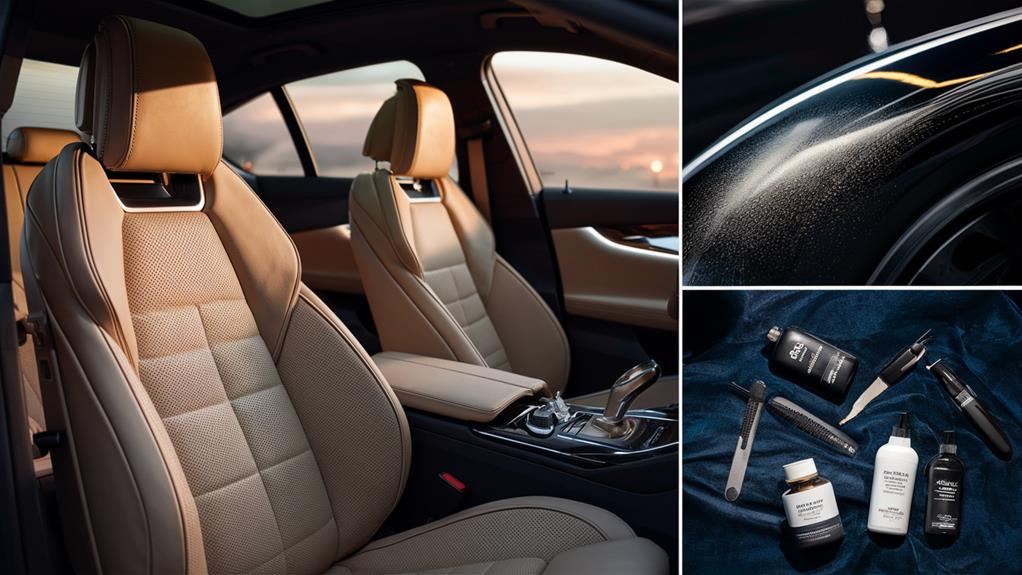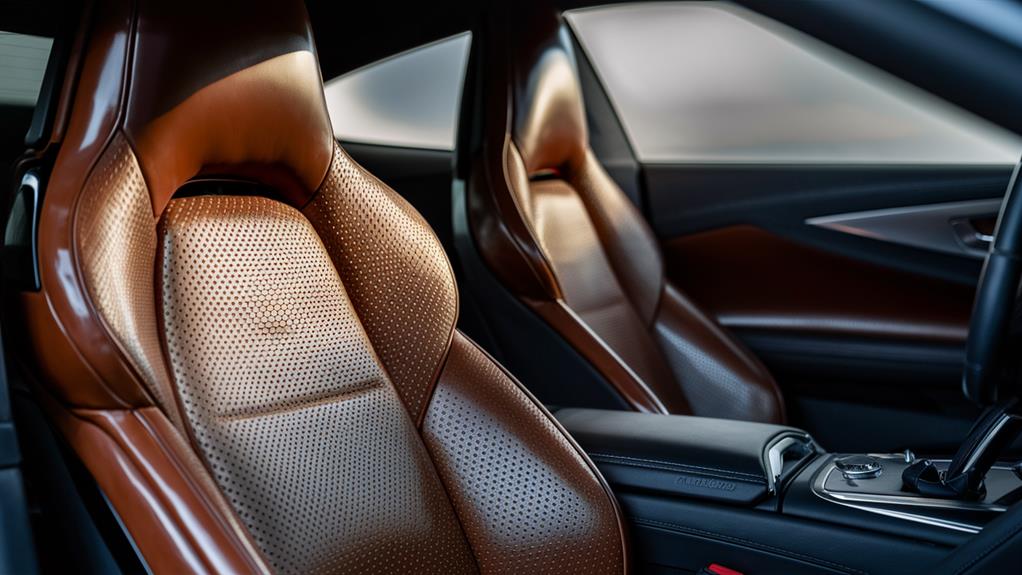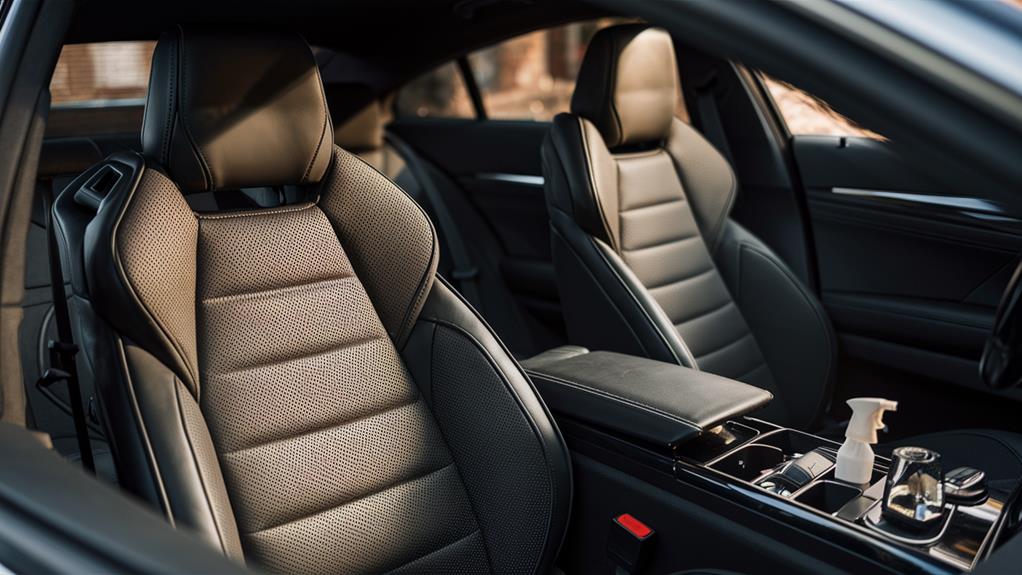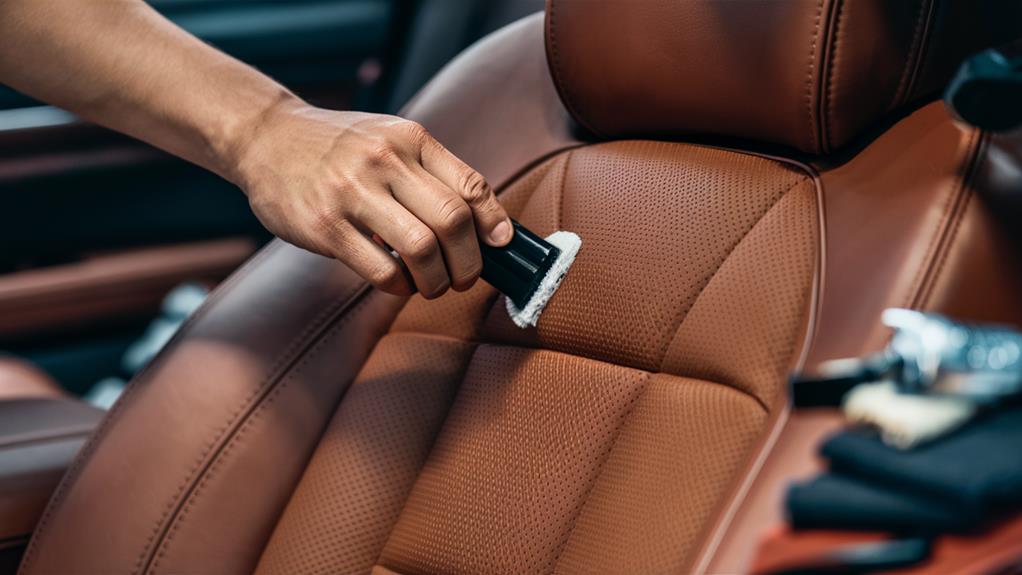Ceramic coating significantly enhances leather care for car interiors by forming a durable, hydrophobic barrier that protects against dirt, UV rays, and stains. This advanced polymer coating reduces maintenance efforts, allowing for easy cleaning and minimizing the risk of permanent stains. It also extends the lifespan of leather by preventing cracking and fading, maintaining its original texture and aesthetic appeal. While the initial investment may be higher than traditional conditioners, the long-term cost-effectiveness and durability it offers make it a superior choice. Discovering the application process and optimal maintenance can further elevate leather’s resilience and appearance.
Key Takeaways
-
- Ceramic coating forms a hydrophobic barrier, repelling water and preventing stains on leather surfaces.
-
- It offers UV protection, reducing fading and cracking, thereby preserving leather aesthetics.
-
- The coating minimizes maintenance efforts, allowing for easier cleaning and less frequent reapplication.
-
- It enhances durability against wear and tear, extending the lifespan of leather interiors.
-
- Regular conditioning is still recommended to maintain the leather’s texture and flexibility.
What Is Ceramic Coating?
Understanding ceramic coating is essential for car owners looking to enhance their vehicle’s interior protection. Ceramic coating is a liquid polymer applied to surfaces, forming a durable layer that bonds with the material underneath. This coating exhibits unique ceramic properties, offering superior resistance to environmental contaminants, UV rays, and chemical exposure.
When applied to leather interiors, the coating creates a hydrophobic surface, making it easier to repel water and prevent stains. The application benefits include reduced maintenance time and enhanced longevity of the leather, helping to preserve its aesthetic appeal and structural integrity.
Moreover, ceramic coatings provide a level of protection that traditional waxing or sealants cannot match, effectively acting as a barrier against scratches and wear. The application process involves meticulous preparation, ensuring that the surface is clean and free of imperfections before the coating is applied. Once cured, the ceramic layer enhances the leather’s natural look while providing a protective shield.
Advantages of Ceramic Coating
Ceramic coating offers several advantages that significantly enhance leather interior protection and maintenance. One of the primary benefits is its durability; ceramic coatings create a robust barrier against wear, reducing the likelihood of cracking, fading, and staining. This long-lasting protection translates to less frequent reapplication compared to traditional leather conditioners, which can save time and effort in the long run.
In terms of cost considerations, the initial investment in ceramic coating might be higher than conventional products. However, the extended lifespan and lower maintenance needs often justify the expenditure, making it a cost-effective solution over time. Users should evaluate their specific needs and vehicle usage patterns before making a decision.
Product recommendations vary, but reputable brands typically offer specialized formulations designed for automotive leather. It’s essential to choose a product that provides comprehensive protection while remaining user-friendly for application. Ensuring compatibility with existing leather treatments is crucial to achieve optimal results. Overall, ceramic coatings present a strategic approach to leather care, combining advanced technology with practical benefits that cater to the demands of modern vehicle interiors.
How It Protects Leather
One of the key ways ceramic coatings protect leather is by forming a hydrophobic barrier that repels water and spills. This protective layer prevents moisture from penetrating the leather’s surface, ensuring that it remains dry and less prone to damage. Consequently, car owners can enjoy longer-lasting leather interiors with minimal maintenance.
In addition to water resistance, ceramic coatings offer several benefits for leather care:
-
- UV Protection: The coatings shield leather from harmful UV rays that can cause fading and cracking over time.
-
- Ease of Cleaning: With a smooth, non-porous surface, dirt and grime can be wiped away effortlessly, reducing the need for frequent deep cleaning.
-
- Enhanced Longevity: By preventing wear and tear, ceramic coatings can extend the life of leather upholstery, making it a cost-effective solution.
Despite some common ceramic coating myths suggesting that they require no maintenance at all, it’s important to follow proper leather maintenance tips. Regular care combined with the protective qualities of ceramic coatings ensures that leather interiors retain their luxurious appearance and durability for years to come.
Stain Resistance Features
Leather’s vulnerability to stains can be significantly mitigated with the application of ceramic coatings. These advanced protective layers create a hydrophobic barrier that repels liquids, preventing them from penetrating the leather’s surface. When spills occur, the ceramic coating allows for easier wipe-up, reducing the risk of permanent staining. This is particularly beneficial in vehicles, where food and drink spills can be common.
Additionally, ceramic coatings enhance color preservation by shielding the leather from UV rays and environmental contaminants that can cause fading over time. By maintaining the leather’s original hue, these coatings help ensure that the interior remains visually appealing and retains its value.
Odor prevention is another crucial feature of ceramic coatings. By sealing the pores of the leather, they inhibit the absorption of odors from spills or environmental factors. This results in a fresher interior that’s less susceptible to unpleasant smells, enhancing the overall driving experience.
Ease of Cleaning
Maintaining a clean car interior is crucial for both aesthetics and hygiene, and ceramic coatings simplify this process significantly. By applying a ceramic coating to leather surfaces, owners can enjoy enhanced ease of cleaning, ensuring that their vehicle remains visually appealing and hygienic with minimal effort.
Ceramic coatings create a hydrophobic layer that repels dirt, liquids, and contaminants, making it easier to maintain leather surfaces. This innovative technology reduces the frequency and intensity of leather maintenance required, allowing for quicker clean-ups and less wear over time.
Key benefits of ceramic coatings for ease of cleaning include:
-
- Effortless Wipe-Downs: Stains and spills can be swiftly wiped away without the need for harsh chemicals, saving time during routine maintenance.
-
- Reduced Scrubbing: The protective layer minimizes the adherence of dirt and grime, decreasing the need for vigorous scrubbing.
-
- Enhanced Longevity of Aesthetics: By protecting against everyday wear, ceramic coatings help preserve the leather’s original look, maintaining the car’s interior aesthetics over time.
Incorporating ceramic coatings into leather care not only streamlines cleaning but also enhances the overall appeal of the vehicle’s interior.
Longevity of Protection
Ceramic coating significantly enhances the longevity of protection for leather interiors by providing extended surface durability. This advanced technology creates a robust barrier that resists wear and tear from daily use, ensuring the leather maintains its appearance and integrity over time. As a result, car owners can enjoy a longer-lasting, pristine interior without frequent maintenance.
Extended Surface Durability
One significant advantage of applying ceramic coating to leather surfaces is the extended durability it offers. This advanced protection significantly enhances the lifespan of leather, making it a wise investment for car owners. The ceramic coating forms a robust barrier that safeguards against environmental factors, ensuring that leather remains in optimal condition over time.
The durability provided by ceramic coatings encompasses several key benefits:
-
- Color Preservation: The coating helps maintain the original hue of the leather, preventing fading caused by sunlight and other environmental elements.
-
- UV Protection: It offers a shield against harmful UV rays, reducing the risk of damage that can lead to cracking and discoloration.
-
- Ease of Maintenance: The smooth surface created by the ceramic coating makes it easier to clean, reducing the frequency and effort needed for upkeep.
Ultimately, ceramic coatings provide an innovative solution for leather care, extending the life of the material while preserving its aesthetic appeal. By investing in this technology, car owners can ensure their interiors remain vibrant and protected against the rigors of daily use.
Resistance to Wear
The longevity of protection offered by ceramic coatings significantly contributes to their appeal among car owners. These advanced coatings enhance the resistance to wear on leather surfaces, extending the life of the interior. By forming a durable, hydrophobic barrier, ceramic coatings minimize the impact of external factors such as dirt, oils, and UV rays, which can degrade leather flexibility over time.
Ceramic coatings effectively reduce the development of wear patterns that often occur from regular use. Traditional leather can show signs of aging, such as cracking and fading, as it endures friction and pressure. However, with a ceramic coating, the leather retains its original texture and appearance, maintaining flexibility while resisting the abrasions typically associated with everyday wear.
Moreover, the easy-to-clean nature of ceramic coatings prevents the accumulation of contaminants that can lead to deterioration. This added layer of protection not only preserves the leather’s aesthetic but also enhances its resilience against the rigors of daily life. As a result, car owners benefit from a significant reduction in maintenance efforts, allowing them to enjoy their vehicle’s interior for years to come.
Application Process Overview
The application process for ceramic coating on leather interiors begins with thorough surface preparation. This step ensures that any dirt, oils, or previous treatments are removed to promote optimal adhesion. Once prepared, various coating application techniques can be employed to achieve a durable, protective finish.
Surface Preparation Steps
Proper surface preparation is crucial for achieving optimal results when applying a ceramic coating to car interiors, particularly leather surfaces. This process ensures that the coating adheres effectively and provides long-lasting protection. It begins with a thorough cleaning to remove dirt, oils, and any previous conditioning residues.
Key steps in the surface preparation process include:
-
- Use appropriate cleaning products: Select pH-balanced cleaning solutions specifically designed for leather. These products effectively eliminate contaminants without damaging the surface.
-
- Inspect for damage: Before conditioning, examine the leather for cracks or signs of wear. Addressing these issues beforehand helps maintain the integrity of the surface.
-
- Leather conditioning: After cleaning, apply a high-quality leather conditioner. This step replenishes moisture and prepares the leather for the ceramic coating, ensuring an even application and enhanced durability.
Following these steps not only enhances the longevity of the ceramic coating but also revitalizes the leather’s appearance. By investing time in proper surface preparation, car owners set the stage for a successful ceramic coating application, ensuring their leather interiors remain protected and visually appealing for years to come.
Coating Application Techniques
Achieving a flawless application of ceramic coating on leather interiors requires careful attention to detail and technique. The process begins with selecting the right application tools, which can significantly influence the end result. For optimal results, detailers often employ specialized spray techniques that ensure even distribution of the coating across the leather surface.
Before application, it’s crucial to prepare the ceramic coating according to manufacturer guidelines, ensuring the product is ready for use. Using high-quality spray bottles designed for automotive coatings can help achieve a fine mist, allowing for better coverage without oversaturation. Detailers typically start by applying the ceramic coating in small sections, working methodically to avoid unevenness.
An important technique involves using cross-hatch patterns during application. This method enhances adhesion and ensures that every area receives adequate coverage. After spraying, a microfiber applicator may be utilized to gently spread the coating, ensuring a uniform finish.
Frequently Asked Questions
Can Ceramic Coating Be Applied to Other Surfaces Besides Leather?
Ceramic coating applications extend beyond leather; they’re effective on alternative surfaces like plastics, metals, and glass. This versatility provides added protection and enhances durability, making it a valuable option for various automotive and household materials.
How Much Does Ceramic Coating Typically Cost for Car Interiors?
Research indicates that ceramic coating can enhance vehicle interior durability by up to 50%. Typically, costs for applying ceramic coating to car interiors range from $300 to $1,500, providing significant leather maintenance benefits when properly maintained.
Will Ceramic Coating Change the Appearance of My Leather?
Ceramic coating won’t drastically alter leather’s appearance, but it provides subtle enhancement, improving shine and depth. This treatment significantly boosts leather longevity, protecting against wear, stains, and environmental damage while maintaining its original aesthetic appeal.
Is Ceramic Coating Safe for All Types of Leather?
Ceramic coating isn’t universally safe for all leather types. It enhances leather longevity and coating effectiveness on treated leathers but may damage untreated or porous materials. Always check compatibility before application to ensure optimal results.
How Often Should Ceramic Coating Be Reapplied for Optimal Protection?
For optimal protection, ceramic coating should be reapplied every six to twelve months, depending on application frequency and environmental conditions. Regular maintenance tips, like cleaning, enhance durability and ensure the coating remains effective over time.
Conclusion
In summary, ceramic coating significantly enhances leather care by providing superior protection and ease of maintenance. With a staggering 80% increase in stain resistance, this innovative solution not only extends the life of car interiors but also simplifies cleaning routines. By investing in ceramic coating, car owners can enjoy a pristine interior while safeguarding against wear and tear. The application process, though detailed, ultimately yields long-lasting benefits that make it a worthwhile choice for any vehicle enthusiast.





